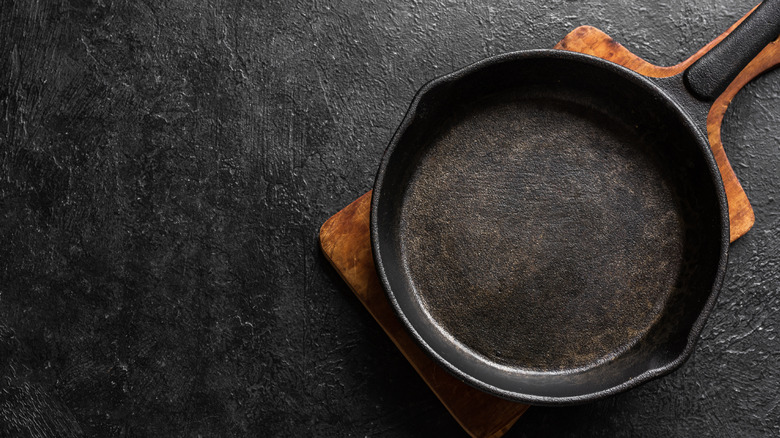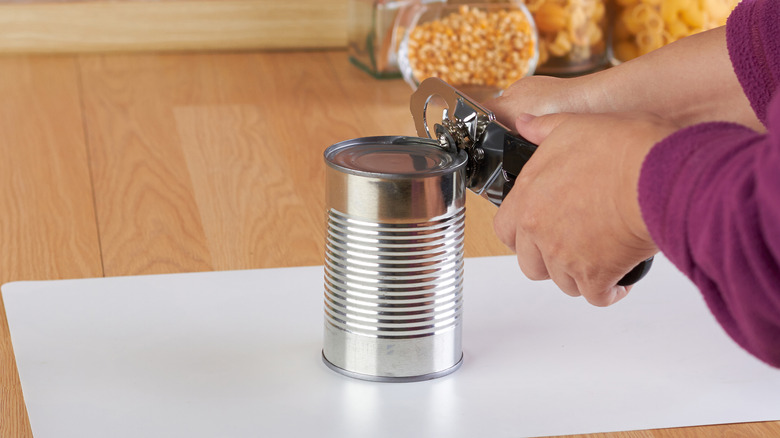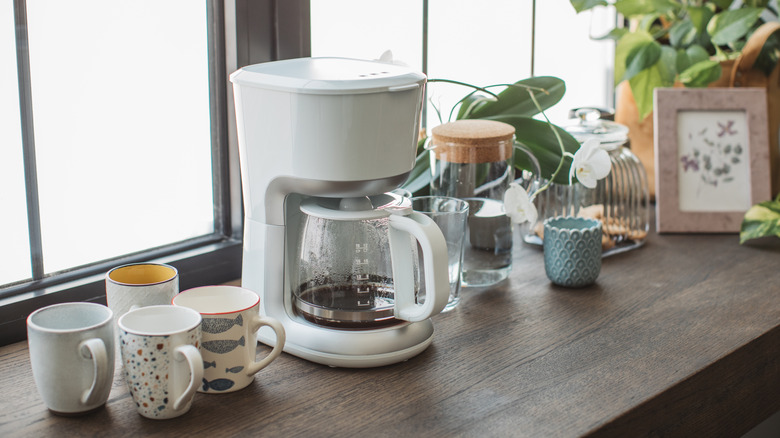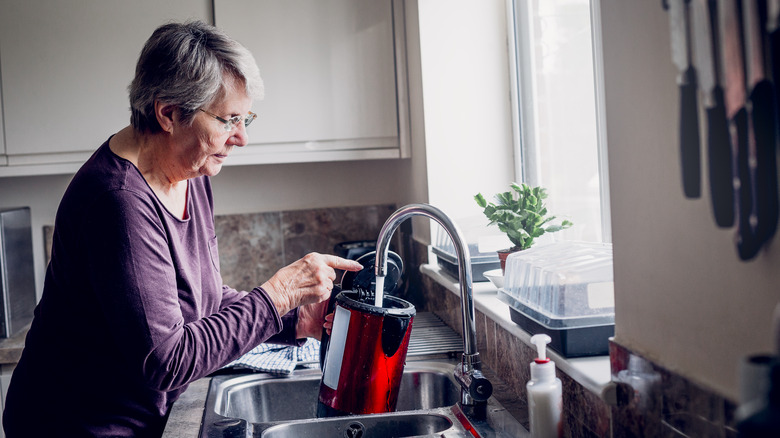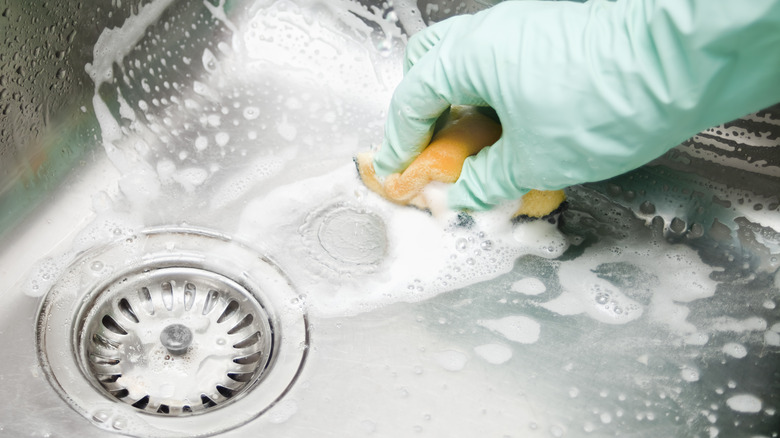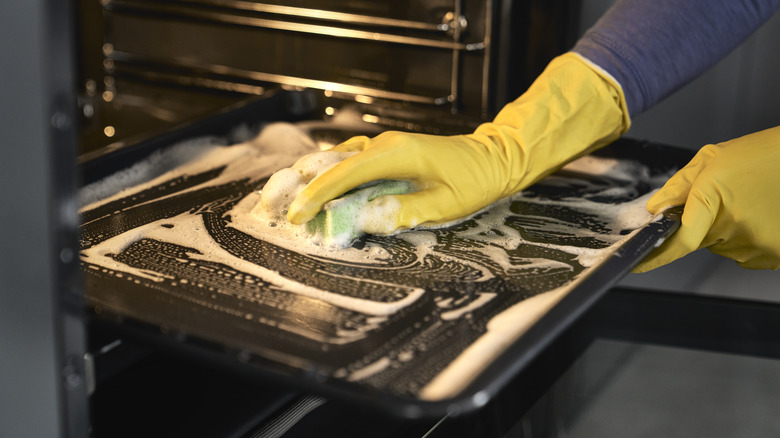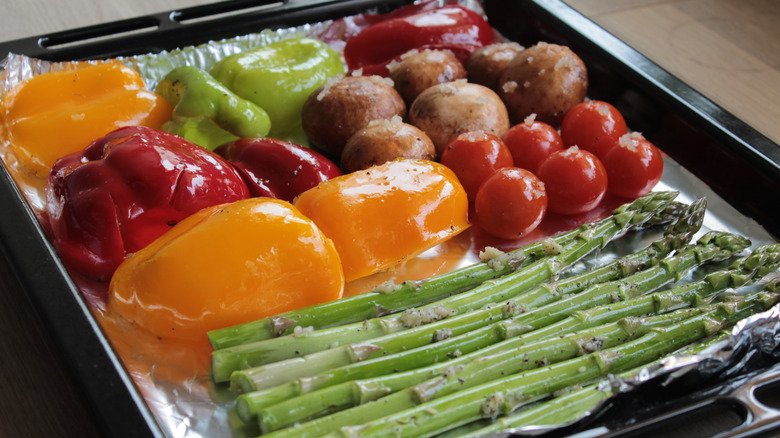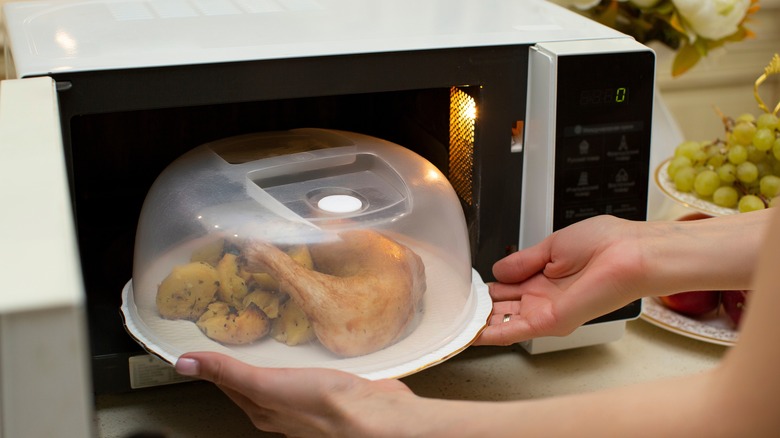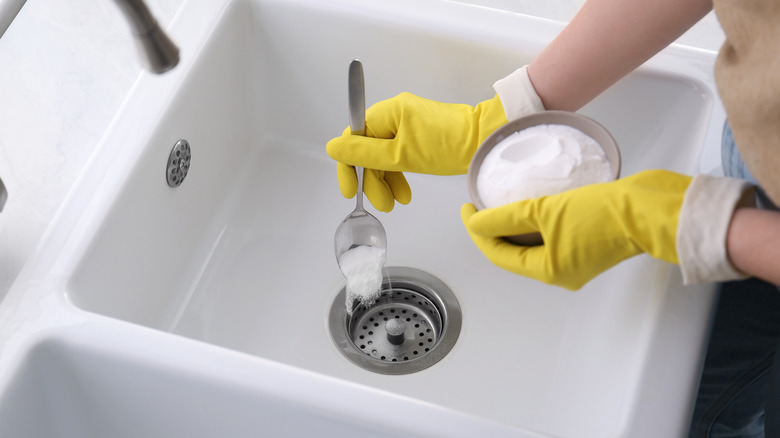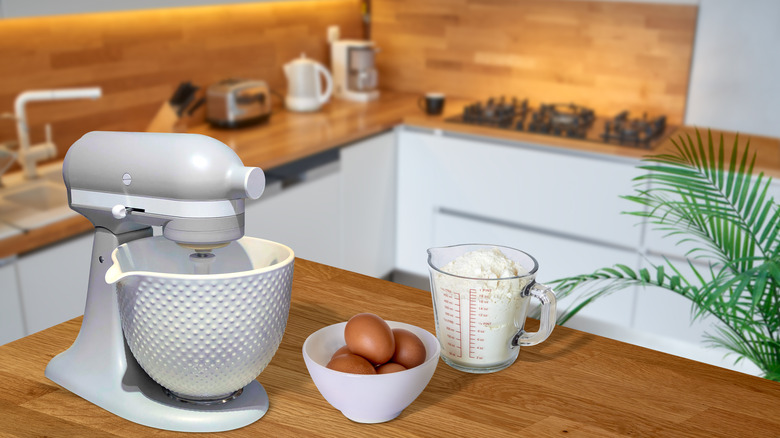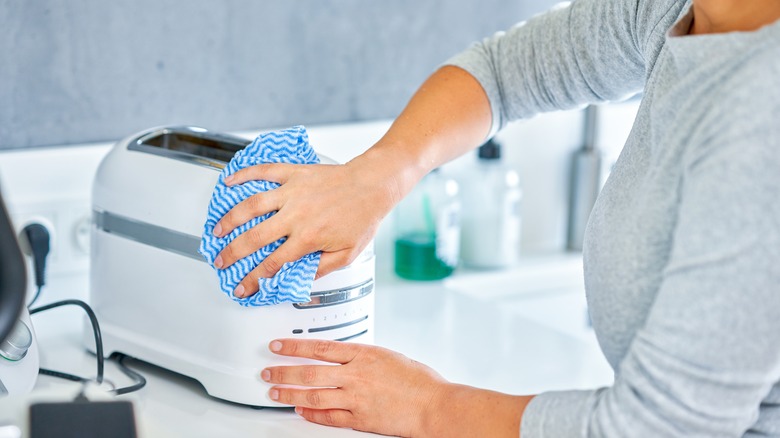You Really Don't Have To Clean These Kitchen Items As Often As You Think
Cleaning the kitchen can often feel like a daunting task. When you realize just how many appliances there are to be scrubbed, along with dishes that need to be washed, crumbs that need to be wiped, and food that needs to be put away, it can feel like an impossible job. But the good news is, you may be wasting time scouring certain kitchen items more often than you need to.
While it is always good to wipe everything down after use, the truth is many objects don't need to be deep cleaned every time. Many appliances can go weeks or even months without a thorough washing. This means you can ease back on some of your tasks in order to focus your energy elsewhere and not spend the entire day scrubbing down every single part of the room. If that sounds good, here is a list of which items in your kitchen can be left for another day's work.
Overcleaning will strip cast iron pans of their seasoning
First off, it's important to note that there are a lot of approaches to cast iron pan care. These heirloom pans have been around for generations, so it's no wonder that there are variations of opinion on the proper way to clean them. However, almost everyone agrees that they do not need to be thoroughly scrubbed with soap after every use. A good cast iron has a layer of carbonized oil called 'seasoning.' Too much or too thorough brushing can strip the pan of this seasoning. This can make food stick to the surface and negate the benefits of using cast iron in the first place.
Instead, you can opt to cook less messy foods in your pan. Avoid thick sauces or ingredients that are likely to stick. When you are finished with your meal, rinse the pan out immediately with warm water, and wipe it down with a paper towel. In many cases, that is enough! However, if there are still food particles stuck, you can use a soft sponge or dish towel and a little bit of mild soap to fully clean. Then, when it's time to re-season your pan, you can do a deep clean with a scrubber and plenty of soap before reseasoning it.
Cleaning can openers can wait
It might feel instinctual to toss your can opener into the sink after every use, but you really don't need to. This tool is designed in such a way that you shouldn't be getting the contents of the can onto it. If you move slowly and don't splash liquid out of the can, your can opener should be just as clean as it was before you started. If you're worried, you can definitely rinse the can opener between uses, but there really is no need to use soap in most cases!
When you splash the contents of your canned goods or notice that something is seeping up into the gears, it's time to clean the can opener. If it's dishwasher-safe, just toss it in a normal cycle. Otherwise, you can gently wipe it down with soap and warm water in the sink using a sponge. Although you don't need to wash with soap every time, it's a good idea to do so at least once a week, to make sure there are no food particles that could begin to rot or harbor bacteria.
You might be cleaning your coffee maker more than needed
As with cast iron pans, there are various schools of thought on the frequency of cleaning for coffee makers. And these can vary widely depending on the equipment you use. However, no matter what type of apparatus you use to make your morning cup of joe, it doesn't need to be cleaned after every use. A simple rinse with warm water is usually enough to get out any coffee grounds that might mold. You only need to deep clean it every once in a while to remove the coffee oil that may have accumulated.
In general, with daily use, you should wash a French press about twice a month and a drip coffee maker or moka pot once a month. Cleaning your coffee maker is important in order to make sure the coffee residue doesn't go rancid. It also gives you an opportunity to clear the filters and make sure all the parts will continue to work in peak condition. The exact method depends on which type you have, but a little soap and warm water are enough for most machines. Just make sure you rinse all the soap off before your next use!
Kettles don't need frequent cleaning
If you use an electric kettle, you don't need to wash it every time you make a cup of tea. If you're using it correctly, this kitchen appliance should only ever contain plain water. That means there are no food particles that could go bad or harbor harmful bacteria. Therefore, the main concern for cleanliness is mineral buildup. The harder your water is, the more limescale could harden in your kettle, causing it to stop working. To prevent this, empty any leftover water after using it and let it dry fully.
By drying out your kettle between uses and never putting any other liquids in it, you can go up to three months without cleaning it. You'll know it's time to clean when you see a white buildup along the bottom and inside walls. When that's the case, just add a little bit of vinegar to a full kettle of water and bring it to a boil. Allow it to cool, empty it, wipe away any residue, and repeat the process if it still looks dirty. Then, rinse it well and leave it open to dry.
Your sink can clean itself
Okay, so your sink can't really clean itself, but it also doesn't need as intensive of a scrub down as you might be giving it. Generally, you use your kitchen sink to clean other things, so it shouldn't get all that dirty. When you finish handwashing dishes, make sure to rinse off the sink and empty out the strainer. If there are any spots or particles, just wipe them down with the sponge you used on the dishes.
Of course, even with a good rinse every time you use the sink, you should do a more thorough cleaning once a week or so. However, if you've handled raw meat in the sink, you should wash it after you're done so that no harmful bacteria can grow. When it's time for a deep clean, a mix of baking soda and vinegar can be a great combination to get it sparkling clean. You should also use your go-to disinfectant spray to eliminate any germs and bacteria.
Ovens don't need to get dirty after every use
Unless you have a baking mishap, the oven is a kitchen appliance that really shouldn't get too dirty with normal use. For the most part, you'll be using a baking tray or dish rather than putting anything loose on the racks. If you're cooking a casserole that might spill over the edges of the dish or a pizza that's supposed to be baked right on the rack, place a large, shallow pan on one of the lower racks. Another way to avoid excess cleaning is to lay a square of tin foil on the bottom of your oven. Either of these will catch any drips and spills and can easily be cleaned or replaced when dirty.
With proper care and average use, an oven should be able to go about three months without cleaning. When it's starting to accumulate grease splatters, or if you've had a mishap and spilled something in the oven, you can wipe down the sides and bottom and then use the built-in cleaning function. Most ovens have a self-cleaning setting for this, so check your user manual to learn how to use yours. You can make sure the appliance is even cleaner by scrubbing it down with a cleaner like Barkeeper's Friend.
Reuse baking trays to avoid constant washing
If you have been scrubbing your baking trays after every use, you might be wasting elbow grease. You can save yourself some time and energy by covering your baking trays with aluminum foil before using them. Another great option is using a silicone baking mat that has the added benefit of being nonstick. This hack works especially well if you are baking something dry, like cookies, chicken nuggets, or rolls. Cook as normal, then remove the tinfoil and you'll have a clean tray. Just wipe off any crumbs and make sure there are no grease spots.
Occasionally, if you cook something with sauce or additional grease, you'll find that some of the liquid gets underneath the foil or mat. In this case, wash the tray with soap and water. If you don't, you may end up cooking the spilled liquid into the tray and making it impossible to get out later.
Microwaves can be kept clean for longer with a splatter cover
Your microwave does not need to be cleaned every time you use it, or even every day. Make sure that you are putting food on a dish instead of directly on the microwave plate. Instead of a paper towel, use a splatter cover over the top of the dish, and you should be able to significantly stretch the time between cleanings.
Of course, some food does leave a mess, or you might forget to use the splatter cover. In this case, it's best to spot clean immediately with a warm wet cloth and a bit of cleaning spray before splatters harden. Since there are still food products going through the microwave, though, it is a good idea to conduct a more thorough cleaning at least once a month even if you don't see any mess. To do this, microwave a container of water to soften any food residue, then wipe the walls down with a sponge and dish soap. Use a cloth and clear water to rinse the surfaces and leave the door open until it dries.
Kitchen drain cleanup made easier
It's no secret that a dirty kitchen drain is pretty gross. Luckily, you can avoid dirty drains or unattainable to-do lists. The secret is to clean as you go. Anytime you use the sink to wash dishes or prepare food, you can empty the strainer and then rinse it well. If there is any residue on the strainer and or drain plug, you can use dish soap and a sponge to clean them off.
In order to really keep your drains spotless and fresh, you should also think about rinsing the pipes themselves. You can pour boiling water down the drain once a week to help break up any clumps that could lead to clogs. Another great option for a deep clean is to pour baking soda and vinegar into the drain and let the reaction fizz away grime. Additionally, you should consider having a professional plumber do a full inspection and cleaning once a year to help ensure your pipes last as long as possible.
Stand mixers just need a good wipe
Baking can be a messy process with hours of cleanup after the baked goods are done. Luckily, you don't need to be scrubbing down the base of your stand mixer after every use. You can use a pouring shield to avoid spills when you are adding ingredients to the mixer. Another way to avoid excess cleaning is to keep a damp cloth on hand and immediately wipe away any spills or splashes as they happen, instead of letting them sit and harden.
You should do a deep clean about every three times you bake. One of the best ways to do this is by mixing distilled white vinegar with warm water. You can use this to wipe down the edges of the appliance. Then use a toothbrush to get in and scrub out the nooks and crannies so that there's no food buildup that can lead to bacteria or bad smells.
The trick to keeping your toaster clean
While it is true that a toaster can quickly accumulate a lot of crumbs, the good news is that you don't need to clean it all that often. In fact, you can really stretch out the time between cleaning by simply emptying out the crumb tray after each use. Along with clearing out the crumbs, just make sure that you keep the toaster stored somewhere out of the way where it won't get dust or rogue food splatters on it.
These habits should get you quite a ways without washing the device. But, it's still a good idea to wipe down your toaster more thoroughly once every week or so, and more if you use it very often. During this deep clean, use a pastry brush to get any remaining crumbs from inside the bread slots. Then shake the toaster upside down to get them out. Wash the tray with soap and water, and wipe down the outside surfaces of the appliance.

